Strategic Marketing: Segmentation, Targeting & Positioning Analysis
VerifiedAdded on 2021/05/31
|16
|3934
|39
Essay
AI Summary
This essay provides a detailed analysis of strategic marketing, emphasizing the Segmentation, Targeting, and Positioning (STP) framework, which is crucial for firms aiming to differentiate themselves and gain a competitive edge. It discusses how market segmentation involves dividing consumers into distinct groups based on characteristics like demographics, psychographics, and behavior, using examples such as Marriott International's diverse hotel brands and tour operators' varied package offerings. The essay further explains the targeting process, where marketers evaluate the commercial attractiveness of each segment and select those that align with their resources, highlighting the importance of profitability, segment size, and accessibility. Finally, it addresses positioning, focusing on creating a unique brand image in consumers' minds through differentiation, using positioning maps and unique selling propositions. The document concludes by emphasizing the dynamic nature of targeting and the need for continuous adaptation to changing market conditions.

Running head: STRATEGIC MARKETING
Strategic Marketing
Name of the Student:
Name of the University:
Author note:
Strategic Marketing
Name of the Student:
Name of the University:
Author note:
Paraphrase This Document
Need a fresh take? Get an instant paraphrase of this document with our AI Paraphraser
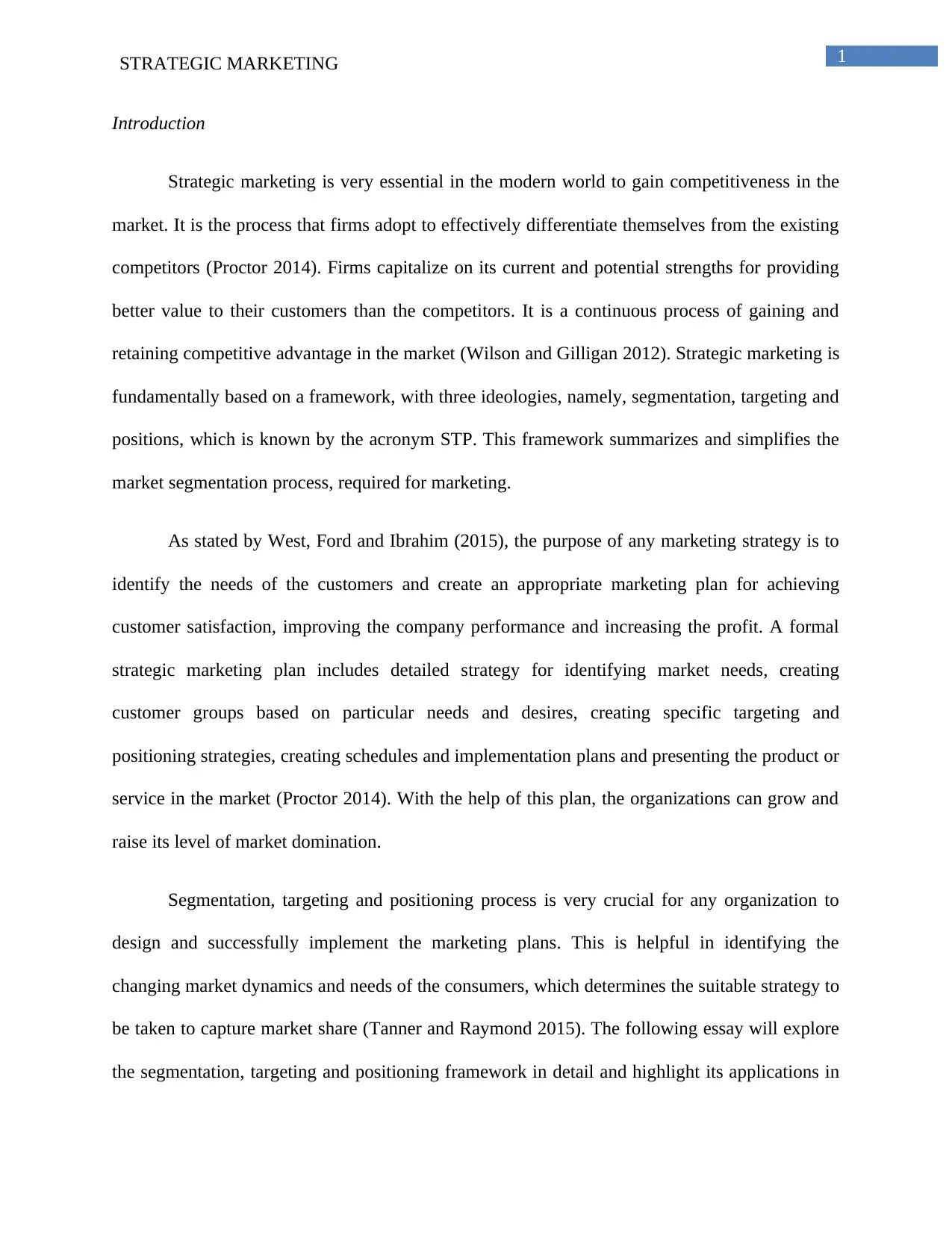
1STRATEGIC MARKETING
Introduction
Strategic marketing is very essential in the modern world to gain competitiveness in the
market. It is the process that firms adopt to effectively differentiate themselves from the existing
competitors (Proctor 2014). Firms capitalize on its current and potential strengths for providing
better value to their customers than the competitors. It is a continuous process of gaining and
retaining competitive advantage in the market (Wilson and Gilligan 2012). Strategic marketing is
fundamentally based on a framework, with three ideologies, namely, segmentation, targeting and
positions, which is known by the acronym STP. This framework summarizes and simplifies the
market segmentation process, required for marketing.
As stated by West, Ford and Ibrahim (2015), the purpose of any marketing strategy is to
identify the needs of the customers and create an appropriate marketing plan for achieving
customer satisfaction, improving the company performance and increasing the profit. A formal
strategic marketing plan includes detailed strategy for identifying market needs, creating
customer groups based on particular needs and desires, creating specific targeting and
positioning strategies, creating schedules and implementation plans and presenting the product or
service in the market (Proctor 2014). With the help of this plan, the organizations can grow and
raise its level of market domination.
Segmentation, targeting and positioning process is very crucial for any organization to
design and successfully implement the marketing plans. This is helpful in identifying the
changing market dynamics and needs of the consumers, which determines the suitable strategy to
be taken to capture market share (Tanner and Raymond 2015). The following essay will explore
the segmentation, targeting and positioning framework in detail and highlight its applications in
Introduction
Strategic marketing is very essential in the modern world to gain competitiveness in the
market. It is the process that firms adopt to effectively differentiate themselves from the existing
competitors (Proctor 2014). Firms capitalize on its current and potential strengths for providing
better value to their customers than the competitors. It is a continuous process of gaining and
retaining competitive advantage in the market (Wilson and Gilligan 2012). Strategic marketing is
fundamentally based on a framework, with three ideologies, namely, segmentation, targeting and
positions, which is known by the acronym STP. This framework summarizes and simplifies the
market segmentation process, required for marketing.
As stated by West, Ford and Ibrahim (2015), the purpose of any marketing strategy is to
identify the needs of the customers and create an appropriate marketing plan for achieving
customer satisfaction, improving the company performance and increasing the profit. A formal
strategic marketing plan includes detailed strategy for identifying market needs, creating
customer groups based on particular needs and desires, creating specific targeting and
positioning strategies, creating schedules and implementation plans and presenting the product or
service in the market (Proctor 2014). With the help of this plan, the organizations can grow and
raise its level of market domination.
Segmentation, targeting and positioning process is very crucial for any organization to
design and successfully implement the marketing plans. This is helpful in identifying the
changing market dynamics and needs of the consumers, which determines the suitable strategy to
be taken to capture market share (Tanner and Raymond 2015). The following essay will explore
the segmentation, targeting and positioning framework in detail and highlight its applications in
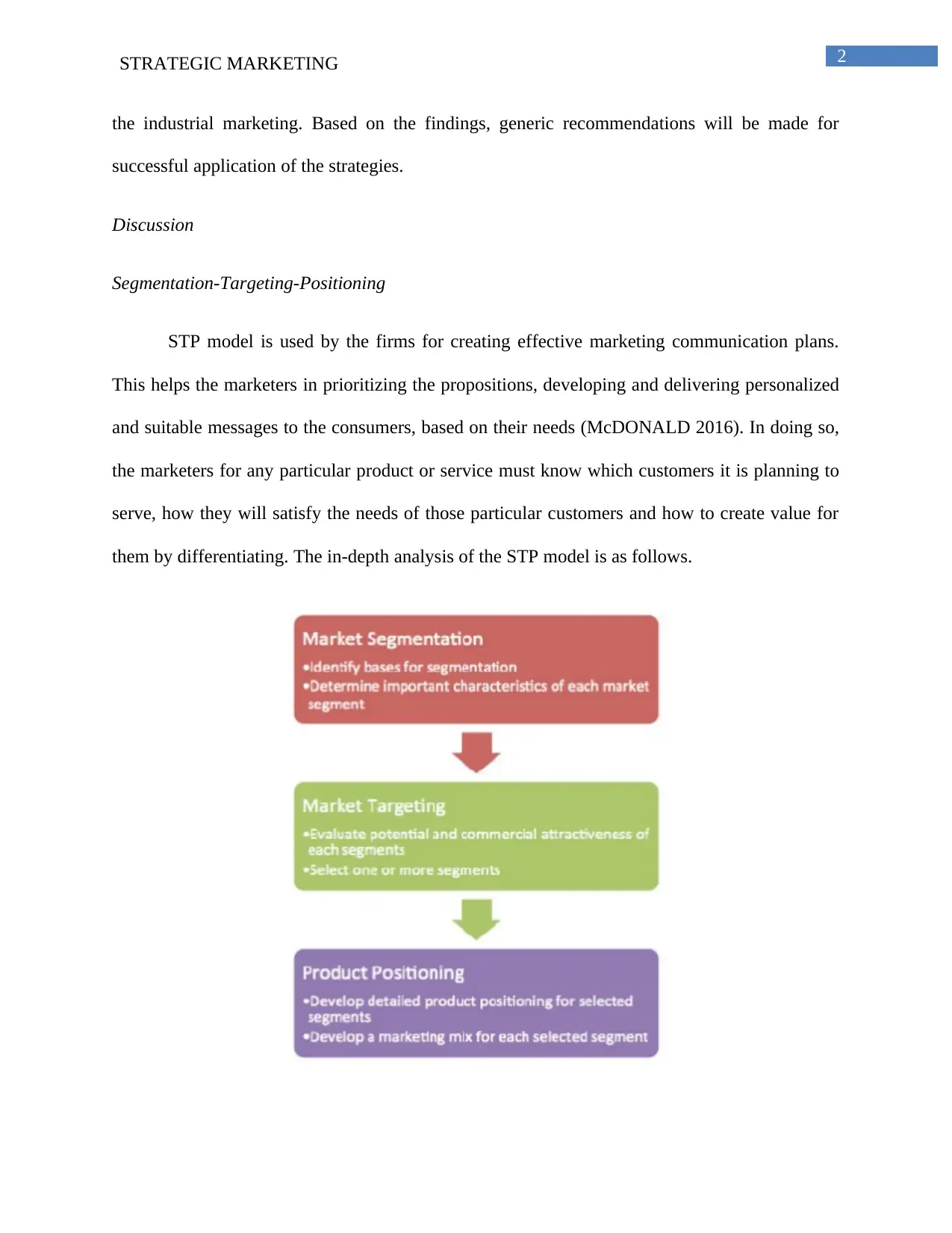
2STRATEGIC MARKETING
the industrial marketing. Based on the findings, generic recommendations will be made for
successful application of the strategies.
Discussion
Segmentation-Targeting-Positioning
STP model is used by the firms for creating effective marketing communication plans.
This helps the marketers in prioritizing the propositions, developing and delivering personalized
and suitable messages to the consumers, based on their needs (McDONALD 2016). In doing so,
the marketers for any particular product or service must know which customers it is planning to
serve, how they will satisfy the needs of those particular customers and how to create value for
them by differentiating. The in-depth analysis of the STP model is as follows.
the industrial marketing. Based on the findings, generic recommendations will be made for
successful application of the strategies.
Discussion
Segmentation-Targeting-Positioning
STP model is used by the firms for creating effective marketing communication plans.
This helps the marketers in prioritizing the propositions, developing and delivering personalized
and suitable messages to the consumers, based on their needs (McDONALD 2016). In doing so,
the marketers for any particular product or service must know which customers it is planning to
serve, how they will satisfy the needs of those particular customers and how to create value for
them by differentiating. The in-depth analysis of the STP model is as follows.
⊘ This is a preview!⊘
Do you want full access?
Subscribe today to unlock all pages.

Trusted by 1+ million students worldwide
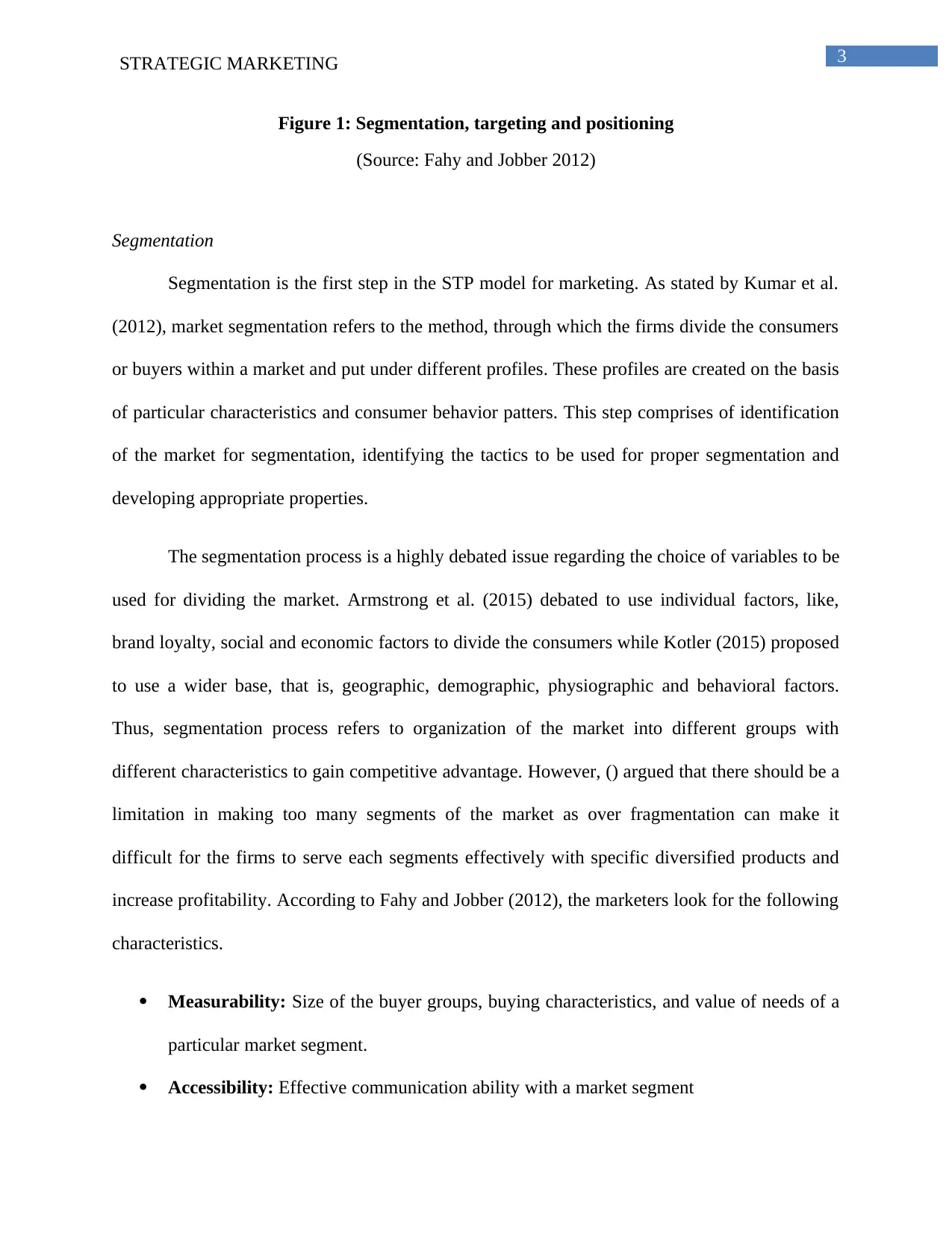
3STRATEGIC MARKETING
Figure 1: Segmentation, targeting and positioning
(Source: Fahy and Jobber 2012)
Segmentation
Segmentation is the first step in the STP model for marketing. As stated by Kumar et al.
(2012), market segmentation refers to the method, through which the firms divide the consumers
or buyers within a market and put under different profiles. These profiles are created on the basis
of particular characteristics and consumer behavior patters. This step comprises of identification
of the market for segmentation, identifying the tactics to be used for proper segmentation and
developing appropriate properties.
The segmentation process is a highly debated issue regarding the choice of variables to be
used for dividing the market. Armstrong et al. (2015) debated to use individual factors, like,
brand loyalty, social and economic factors to divide the consumers while Kotler (2015) proposed
to use a wider base, that is, geographic, demographic, physiographic and behavioral factors.
Thus, segmentation process refers to organization of the market into different groups with
different characteristics to gain competitive advantage. However, () argued that there should be a
limitation in making too many segments of the market as over fragmentation can make it
difficult for the firms to serve each segments effectively with specific diversified products and
increase profitability. According to Fahy and Jobber (2012), the marketers look for the following
characteristics.
Measurability: Size of the buyer groups, buying characteristics, and value of needs of a
particular market segment.
Accessibility: Effective communication ability with a market segment
Figure 1: Segmentation, targeting and positioning
(Source: Fahy and Jobber 2012)
Segmentation
Segmentation is the first step in the STP model for marketing. As stated by Kumar et al.
(2012), market segmentation refers to the method, through which the firms divide the consumers
or buyers within a market and put under different profiles. These profiles are created on the basis
of particular characteristics and consumer behavior patters. This step comprises of identification
of the market for segmentation, identifying the tactics to be used for proper segmentation and
developing appropriate properties.
The segmentation process is a highly debated issue regarding the choice of variables to be
used for dividing the market. Armstrong et al. (2015) debated to use individual factors, like,
brand loyalty, social and economic factors to divide the consumers while Kotler (2015) proposed
to use a wider base, that is, geographic, demographic, physiographic and behavioral factors.
Thus, segmentation process refers to organization of the market into different groups with
different characteristics to gain competitive advantage. However, () argued that there should be a
limitation in making too many segments of the market as over fragmentation can make it
difficult for the firms to serve each segments effectively with specific diversified products and
increase profitability. According to Fahy and Jobber (2012), the marketers look for the following
characteristics.
Measurability: Size of the buyer groups, buying characteristics, and value of needs of a
particular market segment.
Accessibility: Effective communication ability with a market segment
Paraphrase This Document
Need a fresh take? Get an instant paraphrase of this document with our AI Paraphraser
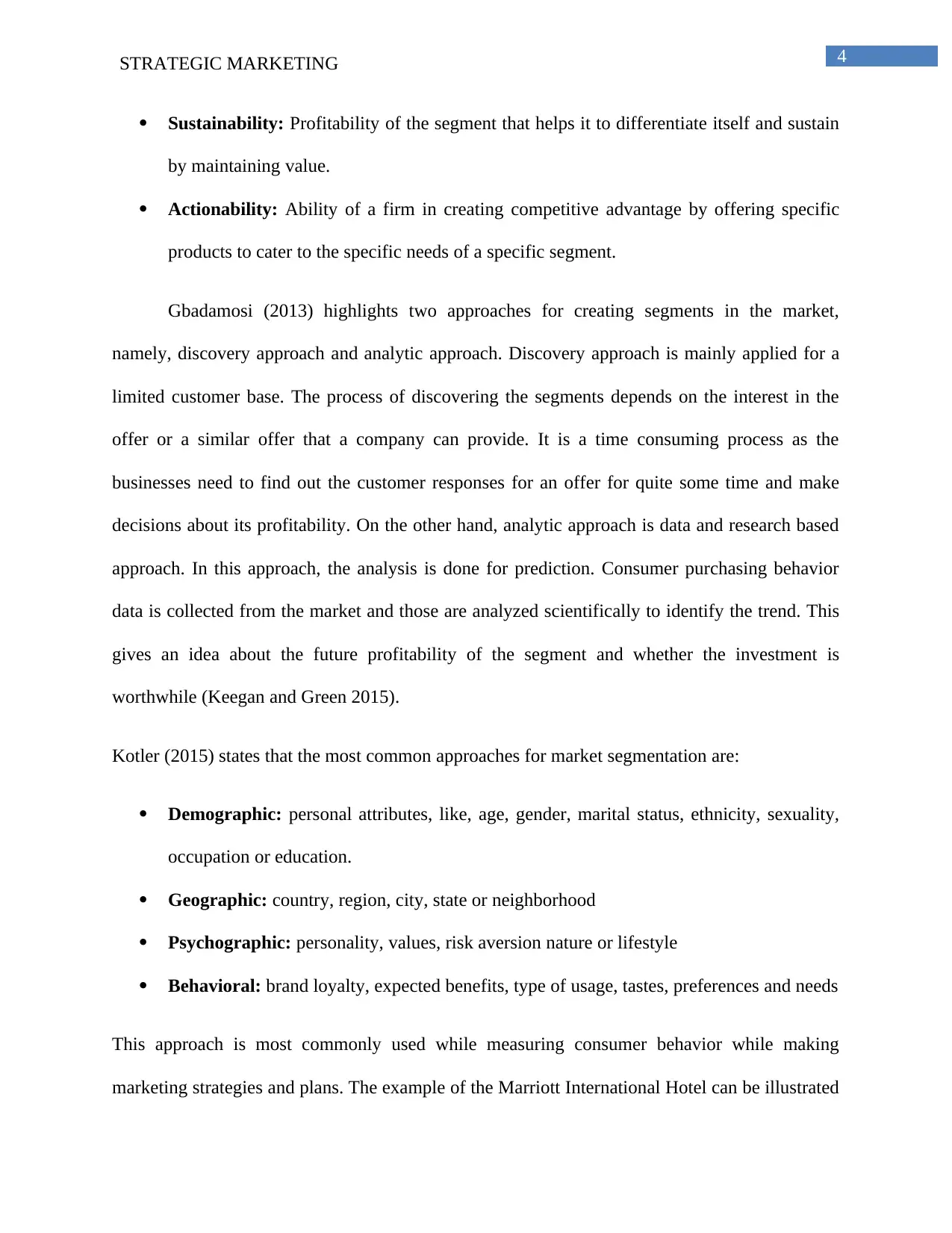
4STRATEGIC MARKETING
Sustainability: Profitability of the segment that helps it to differentiate itself and sustain
by maintaining value.
Actionability: Ability of a firm in creating competitive advantage by offering specific
products to cater to the specific needs of a specific segment.
Gbadamosi (2013) highlights two approaches for creating segments in the market,
namely, discovery approach and analytic approach. Discovery approach is mainly applied for a
limited customer base. The process of discovering the segments depends on the interest in the
offer or a similar offer that a company can provide. It is a time consuming process as the
businesses need to find out the customer responses for an offer for quite some time and make
decisions about its profitability. On the other hand, analytic approach is data and research based
approach. In this approach, the analysis is done for prediction. Consumer purchasing behavior
data is collected from the market and those are analyzed scientifically to identify the trend. This
gives an idea about the future profitability of the segment and whether the investment is
worthwhile (Keegan and Green 2015).
Kotler (2015) states that the most common approaches for market segmentation are:
Demographic: personal attributes, like, age, gender, marital status, ethnicity, sexuality,
occupation or education.
Geographic: country, region, city, state or neighborhood
Psychographic: personality, values, risk aversion nature or lifestyle
Behavioral: brand loyalty, expected benefits, type of usage, tastes, preferences and needs
This approach is most commonly used while measuring consumer behavior while making
marketing strategies and plans. The example of the Marriott International Hotel can be illustrated
Sustainability: Profitability of the segment that helps it to differentiate itself and sustain
by maintaining value.
Actionability: Ability of a firm in creating competitive advantage by offering specific
products to cater to the specific needs of a specific segment.
Gbadamosi (2013) highlights two approaches for creating segments in the market,
namely, discovery approach and analytic approach. Discovery approach is mainly applied for a
limited customer base. The process of discovering the segments depends on the interest in the
offer or a similar offer that a company can provide. It is a time consuming process as the
businesses need to find out the customer responses for an offer for quite some time and make
decisions about its profitability. On the other hand, analytic approach is data and research based
approach. In this approach, the analysis is done for prediction. Consumer purchasing behavior
data is collected from the market and those are analyzed scientifically to identify the trend. This
gives an idea about the future profitability of the segment and whether the investment is
worthwhile (Keegan and Green 2015).
Kotler (2015) states that the most common approaches for market segmentation are:
Demographic: personal attributes, like, age, gender, marital status, ethnicity, sexuality,
occupation or education.
Geographic: country, region, city, state or neighborhood
Psychographic: personality, values, risk aversion nature or lifestyle
Behavioral: brand loyalty, expected benefits, type of usage, tastes, preferences and needs
This approach is most commonly used while measuring consumer behavior while making
marketing strategies and plans. The example of the Marriott International Hotel can be illustrated
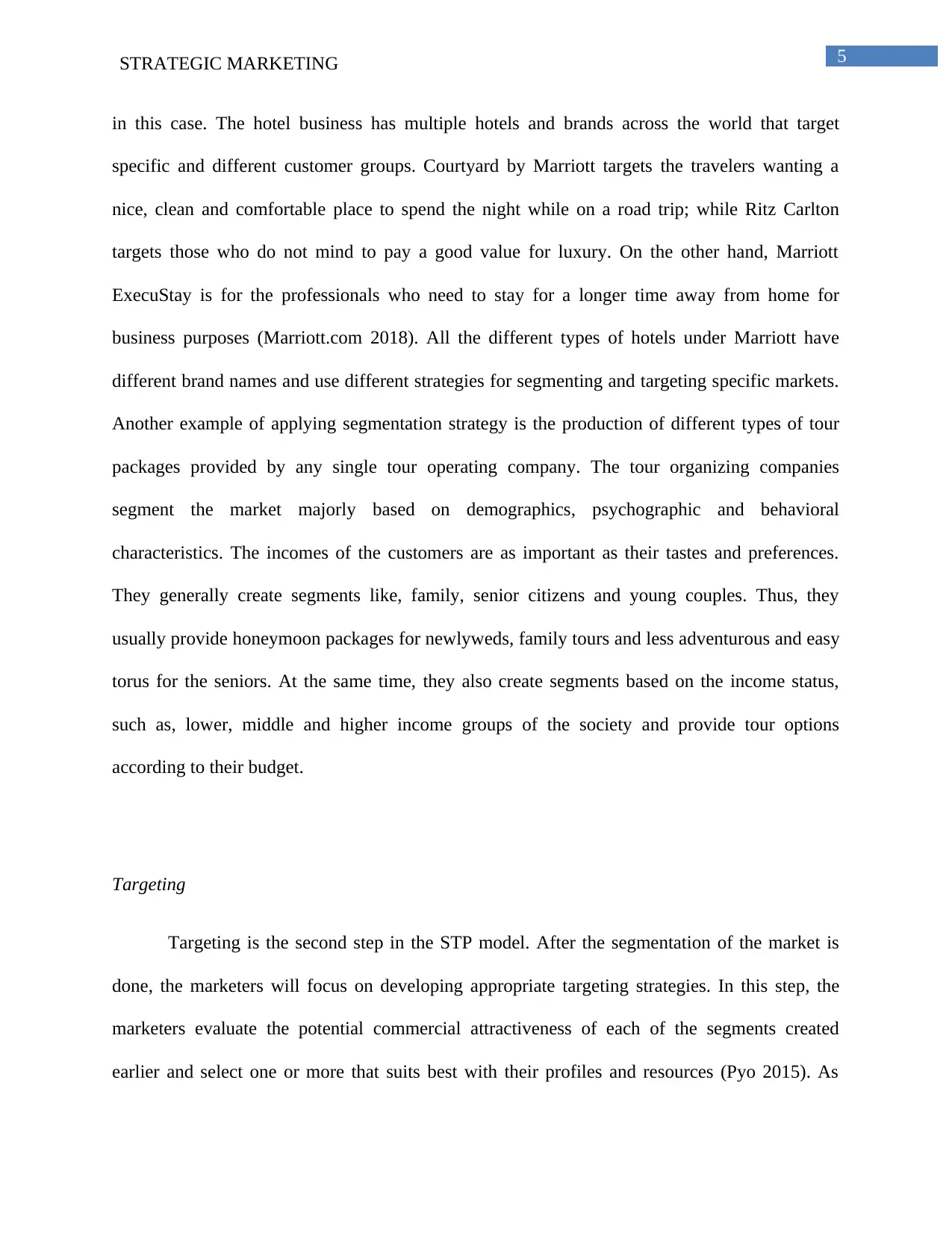
5STRATEGIC MARKETING
in this case. The hotel business has multiple hotels and brands across the world that target
specific and different customer groups. Courtyard by Marriott targets the travelers wanting a
nice, clean and comfortable place to spend the night while on a road trip; while Ritz Carlton
targets those who do not mind to pay a good value for luxury. On the other hand, Marriott
ExecuStay is for the professionals who need to stay for a longer time away from home for
business purposes (Marriott.com 2018). All the different types of hotels under Marriott have
different brand names and use different strategies for segmenting and targeting specific markets.
Another example of applying segmentation strategy is the production of different types of tour
packages provided by any single tour operating company. The tour organizing companies
segment the market majorly based on demographics, psychographic and behavioral
characteristics. The incomes of the customers are as important as their tastes and preferences.
They generally create segments like, family, senior citizens and young couples. Thus, they
usually provide honeymoon packages for newlyweds, family tours and less adventurous and easy
torus for the seniors. At the same time, they also create segments based on the income status,
such as, lower, middle and higher income groups of the society and provide tour options
according to their budget.
Targeting
Targeting is the second step in the STP model. After the segmentation of the market is
done, the marketers will focus on developing appropriate targeting strategies. In this step, the
marketers evaluate the potential commercial attractiveness of each of the segments created
earlier and select one or more that suits best with their profiles and resources (Pyo 2015). As
in this case. The hotel business has multiple hotels and brands across the world that target
specific and different customer groups. Courtyard by Marriott targets the travelers wanting a
nice, clean and comfortable place to spend the night while on a road trip; while Ritz Carlton
targets those who do not mind to pay a good value for luxury. On the other hand, Marriott
ExecuStay is for the professionals who need to stay for a longer time away from home for
business purposes (Marriott.com 2018). All the different types of hotels under Marriott have
different brand names and use different strategies for segmenting and targeting specific markets.
Another example of applying segmentation strategy is the production of different types of tour
packages provided by any single tour operating company. The tour organizing companies
segment the market majorly based on demographics, psychographic and behavioral
characteristics. The incomes of the customers are as important as their tastes and preferences.
They generally create segments like, family, senior citizens and young couples. Thus, they
usually provide honeymoon packages for newlyweds, family tours and less adventurous and easy
torus for the seniors. At the same time, they also create segments based on the income status,
such as, lower, middle and higher income groups of the society and provide tour options
according to their budget.
Targeting
Targeting is the second step in the STP model. After the segmentation of the market is
done, the marketers will focus on developing appropriate targeting strategies. In this step, the
marketers evaluate the potential commercial attractiveness of each of the segments created
earlier and select one or more that suits best with their profiles and resources (Pyo 2015). As
⊘ This is a preview!⊘
Do you want full access?
Subscribe today to unlock all pages.

Trusted by 1+ million students worldwide
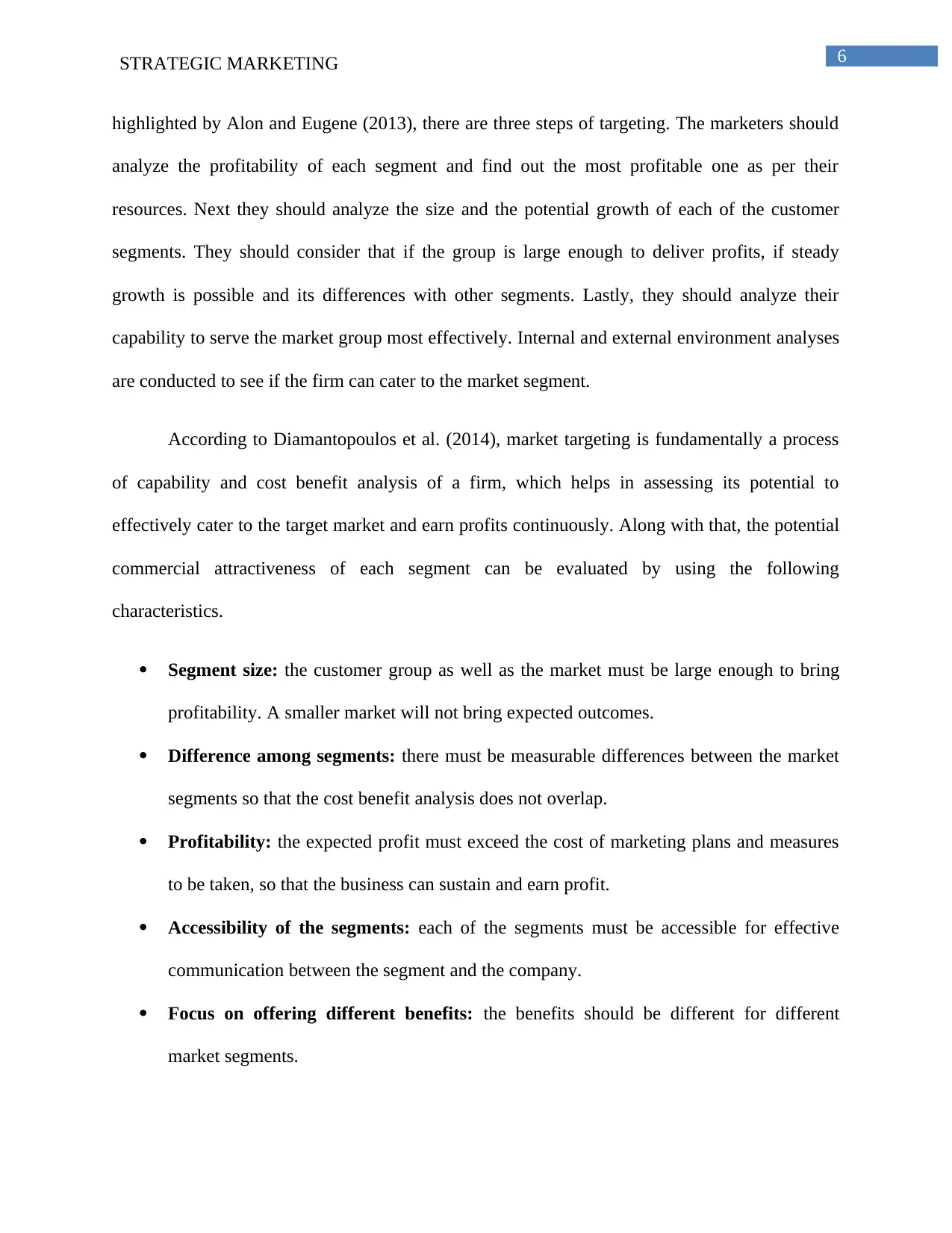
6STRATEGIC MARKETING
highlighted by Alon and Eugene (2013), there are three steps of targeting. The marketers should
analyze the profitability of each segment and find out the most profitable one as per their
resources. Next they should analyze the size and the potential growth of each of the customer
segments. They should consider that if the group is large enough to deliver profits, if steady
growth is possible and its differences with other segments. Lastly, they should analyze their
capability to serve the market group most effectively. Internal and external environment analyses
are conducted to see if the firm can cater to the market segment.
According to Diamantopoulos et al. (2014), market targeting is fundamentally a process
of capability and cost benefit analysis of a firm, which helps in assessing its potential to
effectively cater to the target market and earn profits continuously. Along with that, the potential
commercial attractiveness of each segment can be evaluated by using the following
characteristics.
Segment size: the customer group as well as the market must be large enough to bring
profitability. A smaller market will not bring expected outcomes.
Difference among segments: there must be measurable differences between the market
segments so that the cost benefit analysis does not overlap.
Profitability: the expected profit must exceed the cost of marketing plans and measures
to be taken, so that the business can sustain and earn profit.
Accessibility of the segments: each of the segments must be accessible for effective
communication between the segment and the company.
Focus on offering different benefits: the benefits should be different for different
market segments.
highlighted by Alon and Eugene (2013), there are three steps of targeting. The marketers should
analyze the profitability of each segment and find out the most profitable one as per their
resources. Next they should analyze the size and the potential growth of each of the customer
segments. They should consider that if the group is large enough to deliver profits, if steady
growth is possible and its differences with other segments. Lastly, they should analyze their
capability to serve the market group most effectively. Internal and external environment analyses
are conducted to see if the firm can cater to the market segment.
According to Diamantopoulos et al. (2014), market targeting is fundamentally a process
of capability and cost benefit analysis of a firm, which helps in assessing its potential to
effectively cater to the target market and earn profits continuously. Along with that, the potential
commercial attractiveness of each segment can be evaluated by using the following
characteristics.
Segment size: the customer group as well as the market must be large enough to bring
profitability. A smaller market will not bring expected outcomes.
Difference among segments: there must be measurable differences between the market
segments so that the cost benefit analysis does not overlap.
Profitability: the expected profit must exceed the cost of marketing plans and measures
to be taken, so that the business can sustain and earn profit.
Accessibility of the segments: each of the segments must be accessible for effective
communication between the segment and the company.
Focus on offering different benefits: the benefits should be different for different
market segments.
Paraphrase This Document
Need a fresh take? Get an instant paraphrase of this document with our AI Paraphraser
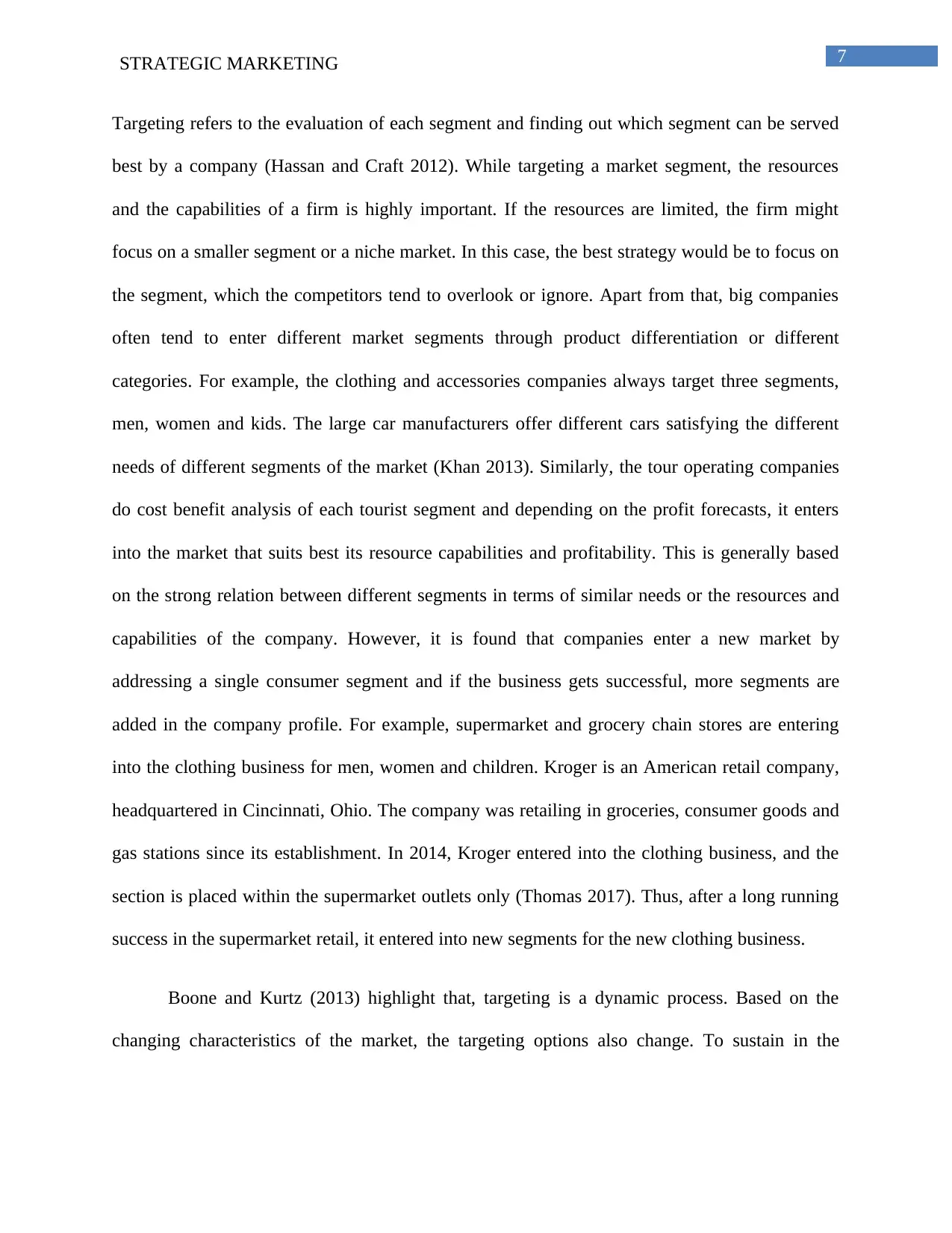
7STRATEGIC MARKETING
Targeting refers to the evaluation of each segment and finding out which segment can be served
best by a company (Hassan and Craft 2012). While targeting a market segment, the resources
and the capabilities of a firm is highly important. If the resources are limited, the firm might
focus on a smaller segment or a niche market. In this case, the best strategy would be to focus on
the segment, which the competitors tend to overlook or ignore. Apart from that, big companies
often tend to enter different market segments through product differentiation or different
categories. For example, the clothing and accessories companies always target three segments,
men, women and kids. The large car manufacturers offer different cars satisfying the different
needs of different segments of the market (Khan 2013). Similarly, the tour operating companies
do cost benefit analysis of each tourist segment and depending on the profit forecasts, it enters
into the market that suits best its resource capabilities and profitability. This is generally based
on the strong relation between different segments in terms of similar needs or the resources and
capabilities of the company. However, it is found that companies enter a new market by
addressing a single consumer segment and if the business gets successful, more segments are
added in the company profile. For example, supermarket and grocery chain stores are entering
into the clothing business for men, women and children. Kroger is an American retail company,
headquartered in Cincinnati, Ohio. The company was retailing in groceries, consumer goods and
gas stations since its establishment. In 2014, Kroger entered into the clothing business, and the
section is placed within the supermarket outlets only (Thomas 2017). Thus, after a long running
success in the supermarket retail, it entered into new segments for the new clothing business.
Boone and Kurtz (2013) highlight that, targeting is a dynamic process. Based on the
changing characteristics of the market, the targeting options also change. To sustain in the
Targeting refers to the evaluation of each segment and finding out which segment can be served
best by a company (Hassan and Craft 2012). While targeting a market segment, the resources
and the capabilities of a firm is highly important. If the resources are limited, the firm might
focus on a smaller segment or a niche market. In this case, the best strategy would be to focus on
the segment, which the competitors tend to overlook or ignore. Apart from that, big companies
often tend to enter different market segments through product differentiation or different
categories. For example, the clothing and accessories companies always target three segments,
men, women and kids. The large car manufacturers offer different cars satisfying the different
needs of different segments of the market (Khan 2013). Similarly, the tour operating companies
do cost benefit analysis of each tourist segment and depending on the profit forecasts, it enters
into the market that suits best its resource capabilities and profitability. This is generally based
on the strong relation between different segments in terms of similar needs or the resources and
capabilities of the company. However, it is found that companies enter a new market by
addressing a single consumer segment and if the business gets successful, more segments are
added in the company profile. For example, supermarket and grocery chain stores are entering
into the clothing business for men, women and children. Kroger is an American retail company,
headquartered in Cincinnati, Ohio. The company was retailing in groceries, consumer goods and
gas stations since its establishment. In 2014, Kroger entered into the clothing business, and the
section is placed within the supermarket outlets only (Thomas 2017). Thus, after a long running
success in the supermarket retail, it entered into new segments for the new clothing business.
Boone and Kurtz (2013) highlight that, targeting is a dynamic process. Based on the
changing characteristics of the market, the targeting options also change. To sustain in the
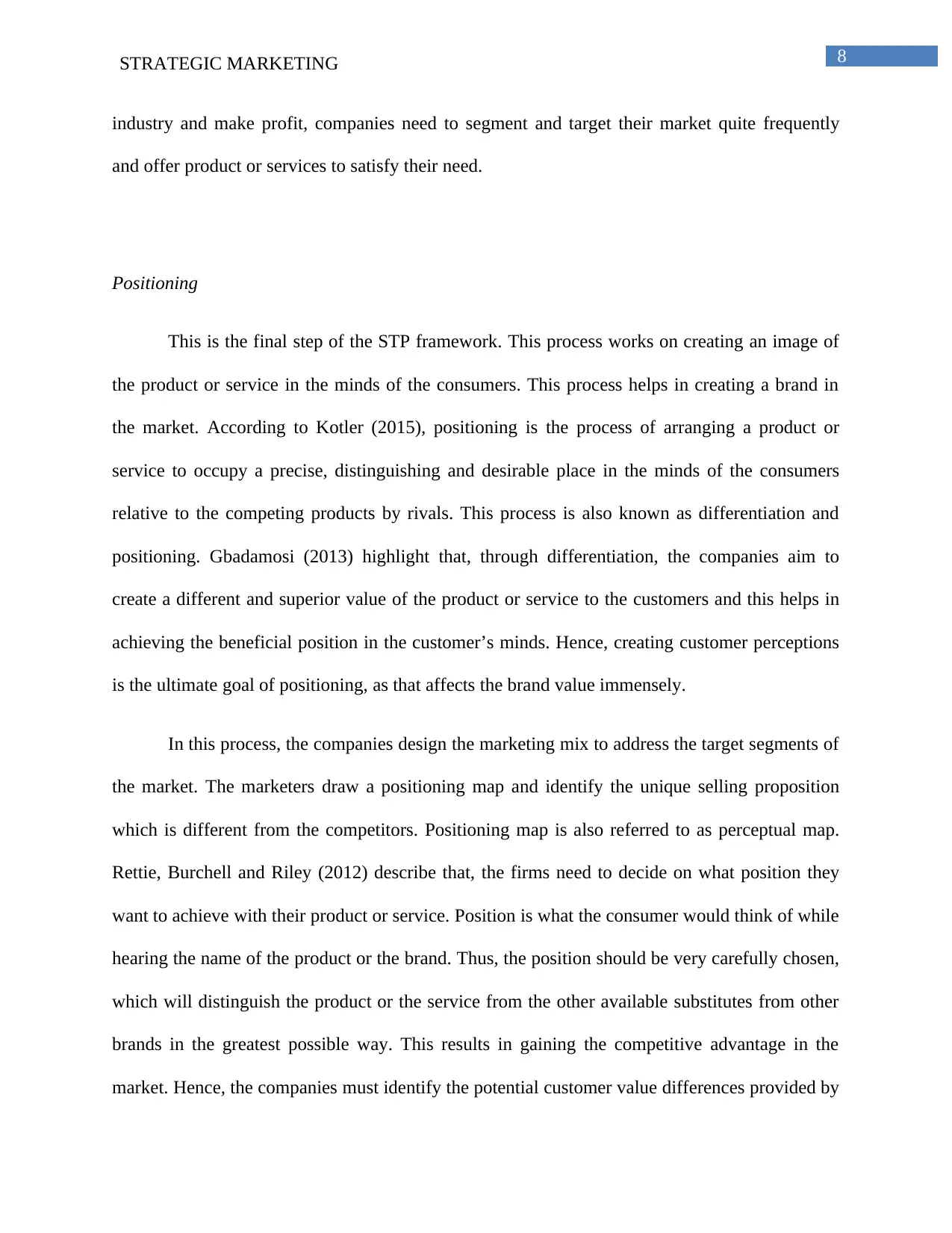
8STRATEGIC MARKETING
industry and make profit, companies need to segment and target their market quite frequently
and offer product or services to satisfy their need.
Positioning
This is the final step of the STP framework. This process works on creating an image of
the product or service in the minds of the consumers. This process helps in creating a brand in
the market. According to Kotler (2015), positioning is the process of arranging a product or
service to occupy a precise, distinguishing and desirable place in the minds of the consumers
relative to the competing products by rivals. This process is also known as differentiation and
positioning. Gbadamosi (2013) highlight that, through differentiation, the companies aim to
create a different and superior value of the product or service to the customers and this helps in
achieving the beneficial position in the customer’s minds. Hence, creating customer perceptions
is the ultimate goal of positioning, as that affects the brand value immensely.
In this process, the companies design the marketing mix to address the target segments of
the market. The marketers draw a positioning map and identify the unique selling proposition
which is different from the competitors. Positioning map is also referred to as perceptual map.
Rettie, Burchell and Riley (2012) describe that, the firms need to decide on what position they
want to achieve with their product or service. Position is what the consumer would think of while
hearing the name of the product or the brand. Thus, the position should be very carefully chosen,
which will distinguish the product or the service from the other available substitutes from other
brands in the greatest possible way. This results in gaining the competitive advantage in the
market. Hence, the companies must identify the potential customer value differences provided by
industry and make profit, companies need to segment and target their market quite frequently
and offer product or services to satisfy their need.
Positioning
This is the final step of the STP framework. This process works on creating an image of
the product or service in the minds of the consumers. This process helps in creating a brand in
the market. According to Kotler (2015), positioning is the process of arranging a product or
service to occupy a precise, distinguishing and desirable place in the minds of the consumers
relative to the competing products by rivals. This process is also known as differentiation and
positioning. Gbadamosi (2013) highlight that, through differentiation, the companies aim to
create a different and superior value of the product or service to the customers and this helps in
achieving the beneficial position in the customer’s minds. Hence, creating customer perceptions
is the ultimate goal of positioning, as that affects the brand value immensely.
In this process, the companies design the marketing mix to address the target segments of
the market. The marketers draw a positioning map and identify the unique selling proposition
which is different from the competitors. Positioning map is also referred to as perceptual map.
Rettie, Burchell and Riley (2012) describe that, the firms need to decide on what position they
want to achieve with their product or service. Position is what the consumer would think of while
hearing the name of the product or the brand. Thus, the position should be very carefully chosen,
which will distinguish the product or the service from the other available substitutes from other
brands in the greatest possible way. This results in gaining the competitive advantage in the
market. Hence, the companies must identify the potential customer value differences provided by
⊘ This is a preview!⊘
Do you want full access?
Subscribe today to unlock all pages.

Trusted by 1+ million students worldwide
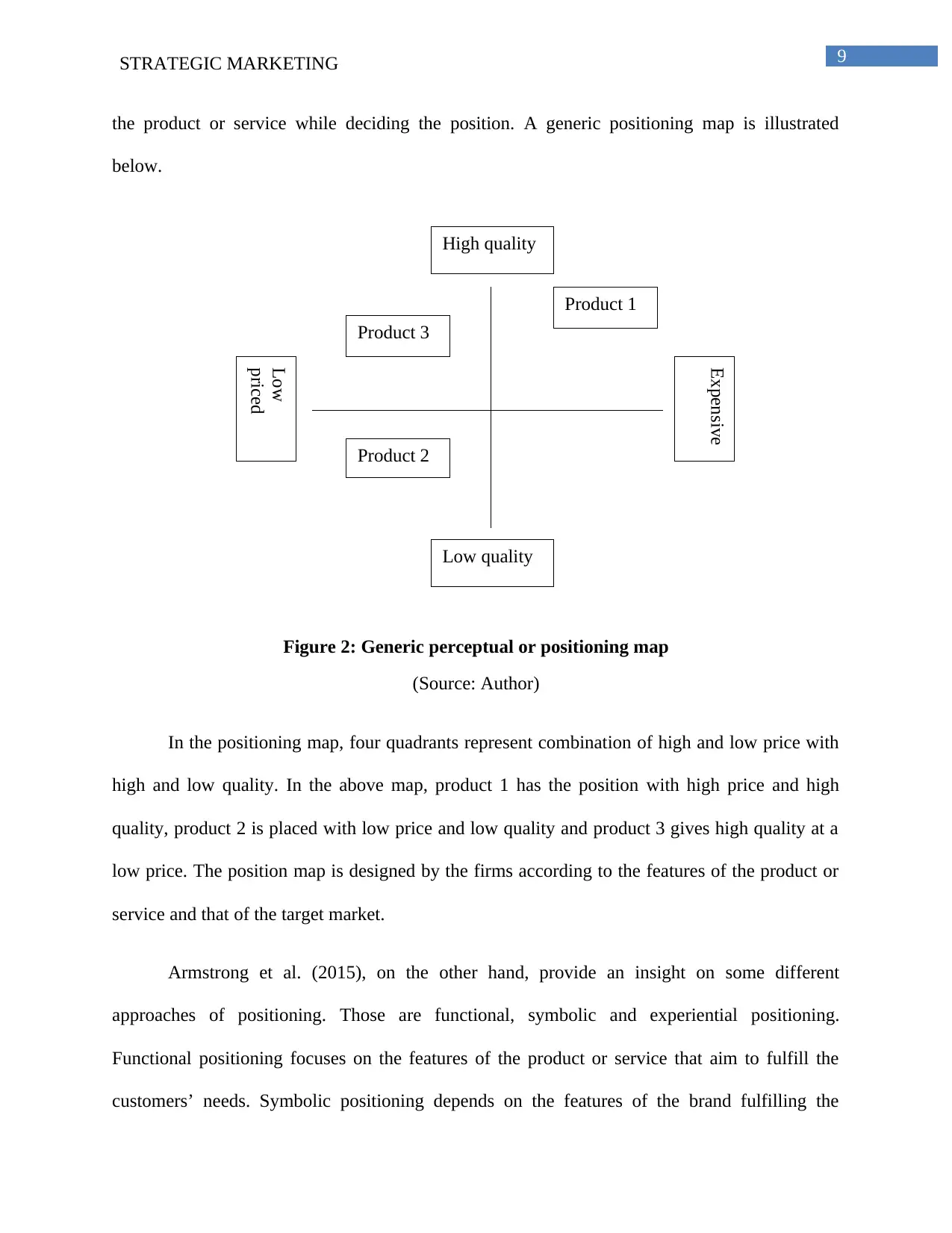
9STRATEGIC MARKETING
High quality
Low quality
Expensive
Low
priced
Product 1
Product 2
Product 3
the product or service while deciding the position. A generic positioning map is illustrated
below.
Figure 2: Generic perceptual or positioning map
(Source: Author)
In the positioning map, four quadrants represent combination of high and low price with
high and low quality. In the above map, product 1 has the position with high price and high
quality, product 2 is placed with low price and low quality and product 3 gives high quality at a
low price. The position map is designed by the firms according to the features of the product or
service and that of the target market.
Armstrong et al. (2015), on the other hand, provide an insight on some different
approaches of positioning. Those are functional, symbolic and experiential positioning.
Functional positioning focuses on the features of the product or service that aim to fulfill the
customers’ needs. Symbolic positioning depends on the features of the brand fulfilling the
High quality
Low quality
Expensive
Low
priced
Product 1
Product 2
Product 3
the product or service while deciding the position. A generic positioning map is illustrated
below.
Figure 2: Generic perceptual or positioning map
(Source: Author)
In the positioning map, four quadrants represent combination of high and low price with
high and low quality. In the above map, product 1 has the position with high price and high
quality, product 2 is placed with low price and low quality and product 3 gives high quality at a
low price. The position map is designed by the firms according to the features of the product or
service and that of the target market.
Armstrong et al. (2015), on the other hand, provide an insight on some different
approaches of positioning. Those are functional, symbolic and experiential positioning.
Functional positioning focuses on the features of the product or service that aim to fulfill the
customers’ needs. Symbolic positioning depends on the features of the brand fulfilling the
Paraphrase This Document
Need a fresh take? Get an instant paraphrase of this document with our AI Paraphraser
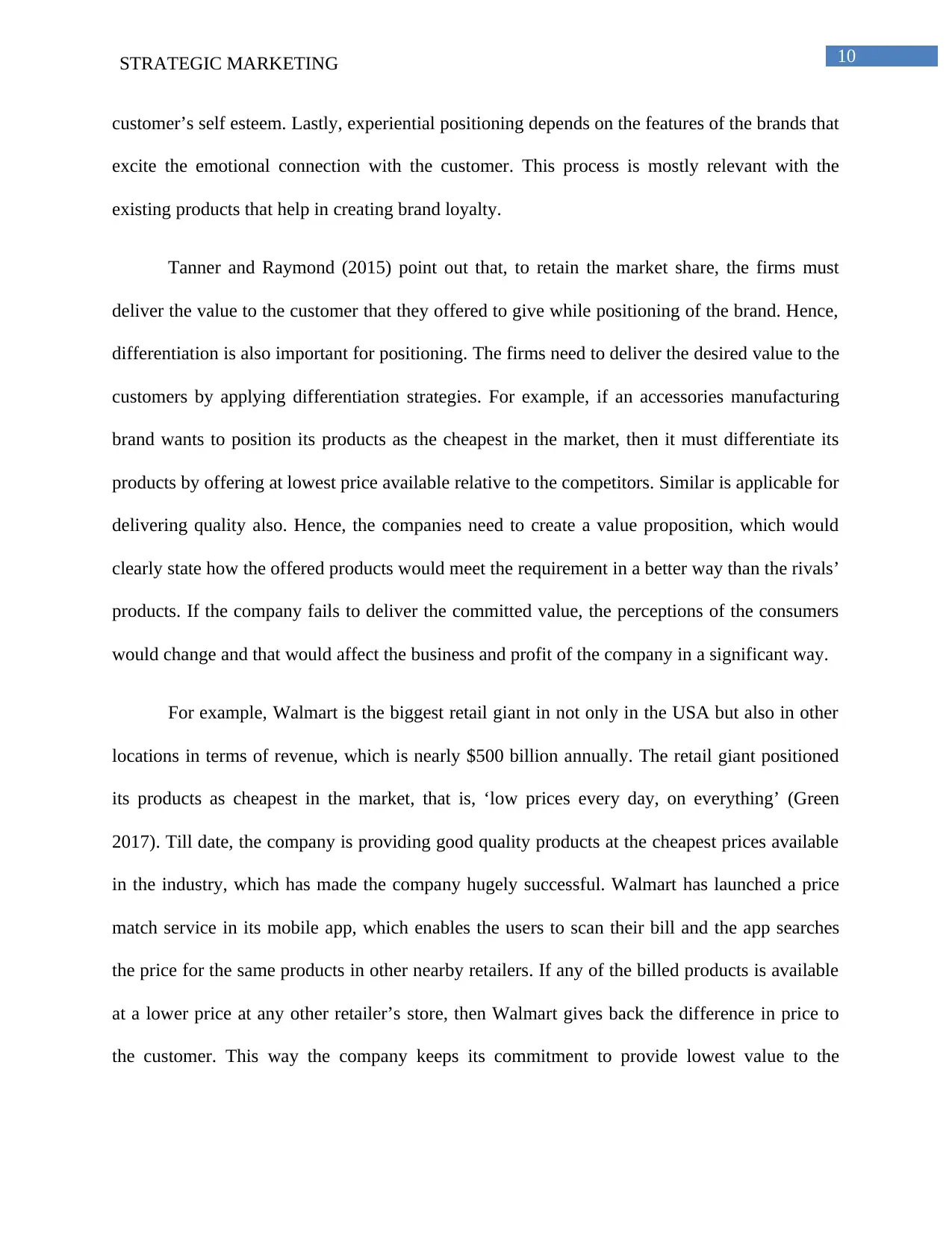
10STRATEGIC MARKETING
customer’s self esteem. Lastly, experiential positioning depends on the features of the brands that
excite the emotional connection with the customer. This process is mostly relevant with the
existing products that help in creating brand loyalty.
Tanner and Raymond (2015) point out that, to retain the market share, the firms must
deliver the value to the customer that they offered to give while positioning of the brand. Hence,
differentiation is also important for positioning. The firms need to deliver the desired value to the
customers by applying differentiation strategies. For example, if an accessories manufacturing
brand wants to position its products as the cheapest in the market, then it must differentiate its
products by offering at lowest price available relative to the competitors. Similar is applicable for
delivering quality also. Hence, the companies need to create a value proposition, which would
clearly state how the offered products would meet the requirement in a better way than the rivals’
products. If the company fails to deliver the committed value, the perceptions of the consumers
would change and that would affect the business and profit of the company in a significant way.
For example, Walmart is the biggest retail giant in not only in the USA but also in other
locations in terms of revenue, which is nearly $500 billion annually. The retail giant positioned
its products as cheapest in the market, that is, ‘low prices every day, on everything’ (Green
2017). Till date, the company is providing good quality products at the cheapest prices available
in the industry, which has made the company hugely successful. Walmart has launched a price
match service in its mobile app, which enables the users to scan their bill and the app searches
the price for the same products in other nearby retailers. If any of the billed products is available
at a lower price at any other retailer’s store, then Walmart gives back the difference in price to
the customer. This way the company keeps its commitment to provide lowest value to the
customer’s self esteem. Lastly, experiential positioning depends on the features of the brands that
excite the emotional connection with the customer. This process is mostly relevant with the
existing products that help in creating brand loyalty.
Tanner and Raymond (2015) point out that, to retain the market share, the firms must
deliver the value to the customer that they offered to give while positioning of the brand. Hence,
differentiation is also important for positioning. The firms need to deliver the desired value to the
customers by applying differentiation strategies. For example, if an accessories manufacturing
brand wants to position its products as the cheapest in the market, then it must differentiate its
products by offering at lowest price available relative to the competitors. Similar is applicable for
delivering quality also. Hence, the companies need to create a value proposition, which would
clearly state how the offered products would meet the requirement in a better way than the rivals’
products. If the company fails to deliver the committed value, the perceptions of the consumers
would change and that would affect the business and profit of the company in a significant way.
For example, Walmart is the biggest retail giant in not only in the USA but also in other
locations in terms of revenue, which is nearly $500 billion annually. The retail giant positioned
its products as cheapest in the market, that is, ‘low prices every day, on everything’ (Green
2017). Till date, the company is providing good quality products at the cheapest prices available
in the industry, which has made the company hugely successful. Walmart has launched a price
match service in its mobile app, which enables the users to scan their bill and the app searches
the price for the same products in other nearby retailers. If any of the billed products is available
at a lower price at any other retailer’s store, then Walmart gives back the difference in price to
the customer. This way the company keeps its commitment to provide lowest value to the
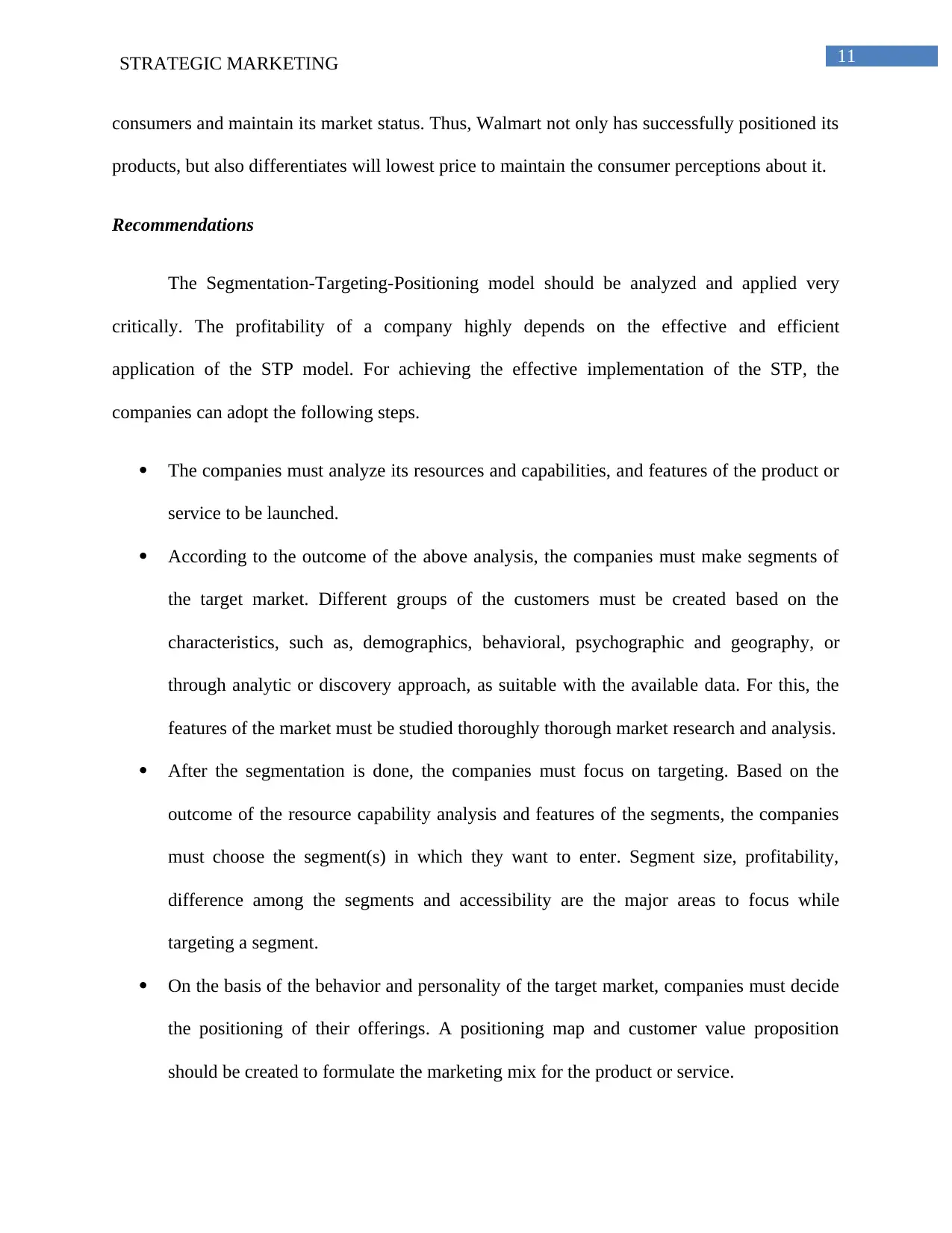
11STRATEGIC MARKETING
consumers and maintain its market status. Thus, Walmart not only has successfully positioned its
products, but also differentiates will lowest price to maintain the consumer perceptions about it.
Recommendations
The Segmentation-Targeting-Positioning model should be analyzed and applied very
critically. The profitability of a company highly depends on the effective and efficient
application of the STP model. For achieving the effective implementation of the STP, the
companies can adopt the following steps.
The companies must analyze its resources and capabilities, and features of the product or
service to be launched.
According to the outcome of the above analysis, the companies must make segments of
the target market. Different groups of the customers must be created based on the
characteristics, such as, demographics, behavioral, psychographic and geography, or
through analytic or discovery approach, as suitable with the available data. For this, the
features of the market must be studied thoroughly thorough market research and analysis.
After the segmentation is done, the companies must focus on targeting. Based on the
outcome of the resource capability analysis and features of the segments, the companies
must choose the segment(s) in which they want to enter. Segment size, profitability,
difference among the segments and accessibility are the major areas to focus while
targeting a segment.
On the basis of the behavior and personality of the target market, companies must decide
the positioning of their offerings. A positioning map and customer value proposition
should be created to formulate the marketing mix for the product or service.
consumers and maintain its market status. Thus, Walmart not only has successfully positioned its
products, but also differentiates will lowest price to maintain the consumer perceptions about it.
Recommendations
The Segmentation-Targeting-Positioning model should be analyzed and applied very
critically. The profitability of a company highly depends on the effective and efficient
application of the STP model. For achieving the effective implementation of the STP, the
companies can adopt the following steps.
The companies must analyze its resources and capabilities, and features of the product or
service to be launched.
According to the outcome of the above analysis, the companies must make segments of
the target market. Different groups of the customers must be created based on the
characteristics, such as, demographics, behavioral, psychographic and geography, or
through analytic or discovery approach, as suitable with the available data. For this, the
features of the market must be studied thoroughly thorough market research and analysis.
After the segmentation is done, the companies must focus on targeting. Based on the
outcome of the resource capability analysis and features of the segments, the companies
must choose the segment(s) in which they want to enter. Segment size, profitability,
difference among the segments and accessibility are the major areas to focus while
targeting a segment.
On the basis of the behavior and personality of the target market, companies must decide
the positioning of their offerings. A positioning map and customer value proposition
should be created to formulate the marketing mix for the product or service.
⊘ This is a preview!⊘
Do you want full access?
Subscribe today to unlock all pages.

Trusted by 1+ million students worldwide
1 out of 16
Related Documents
Your All-in-One AI-Powered Toolkit for Academic Success.
+13062052269
info@desklib.com
Available 24*7 on WhatsApp / Email
![[object Object]](/_next/static/media/star-bottom.7253800d.svg)
Unlock your academic potential
Copyright © 2020–2025 A2Z Services. All Rights Reserved. Developed and managed by ZUCOL.





